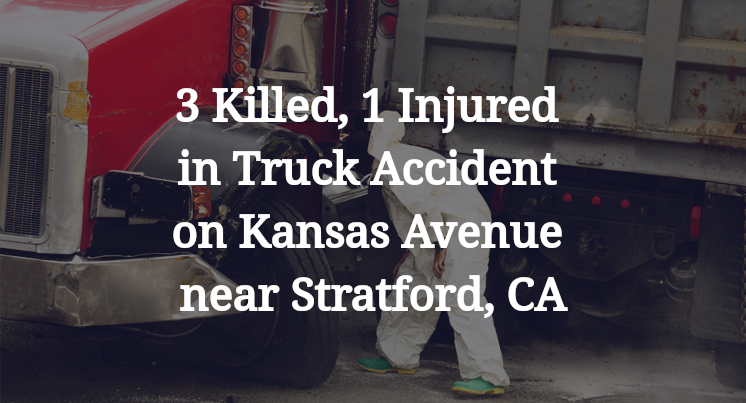3 Killed, 1 Injured in Truck Accident on Kansas Avenue near Stratford, CA
Kings County, CA — January 24, 2025, three people were killed and another person was injured in a truck accident at about 11:45 p.m. at the intersection of Kansas Avenue and 17th Avenue.
Authorities said a 2020 Peterbilt semi-truck was going east on Kansas Avenue when a 2017 Toyota Camry headed south of 17th Avenue apparently failed to yield. The two vehicles collided in the intersection, forcing the Toyota into a metal pole.

Two passengers in the Toyota died at the scene of the crash, while a third died after being transported to a local hospital, according to authorities. Their names have not been made public at this time.
The driver was hospitalized with moderate injuries, and another passenger was treated on the scene, authorities said.
The truck driver was not injured.
Authorities have not released any additional information about the crash. The accident is still under investigation.
Commentary by Attorney Michael Grossman
When I read about a crash like this, the first question that comes to mind is, "What led to the apparent failure to yield?" While it’s easy to assume that one party’s mistake caused the crash, my experience has taught me that intersection collisions often involve a combination of factors that need to be carefully examined.
One critical aspect to investigate is the design and control of the intersection itself. Were there traffic lights, stop signs, or other controls at the intersection of Kansas Avenue and 17th Avenue? If so, were they functioning properly at the time of the crash? It’s also important to assess whether the visibility at the intersection was clear. Poor lighting, obstructed sightlines or faded markings can make it difficult for drivers to navigate safely. These details are crucial in determining whether any external factors contributed to the crash.
The condition and behavior of the Toyota Camry’s driver also deserve scrutiny. Authorities noted that the vehicle may have failed to yield, but it’s important to ask why that happened. Was the driver distracted or fatigued? Were they unfamiliar with the area? Did they misinterpret the traffic controls? Investigators should examine cell phone records, witness statements and other evidence to help answer these questions.
The role of the semi-truck and its driver must also be considered. Even though the truck driver appears to have had the right of way, investigators need to confirm that the truck was traveling at a safe speed and that its driver acted appropriately upon seeing the Toyota. The truck’s engine control module (ECM) data, dashcam footage and the driver’s training records can provide insight into whether the truck driver took reasonable measures to avoid the crash.
Finally, it’s critical to examine the severity of the collision and its aftermath. The fact that the Toyota was forced into a metal pole indicates a violent impact. Investigators should look into whether the vehicle’s safety features, such as airbags and structural integrity, performed as expected. If not, it’s worth asking whether a defect or improper maintenance played a role in the outcome.
Crashes like this highlight how complex intersection collisions can be. Determining what happened requires a detailed investigation into the vehicles, the intersection and the actions of everyone involved. Without looking at all the evidence, it’s impossible to understand the full picture of what happened at this intersection.

“These are essential reads for anyone dealing with the aftermath of a truck wreck”– Attorney Cory Carlson